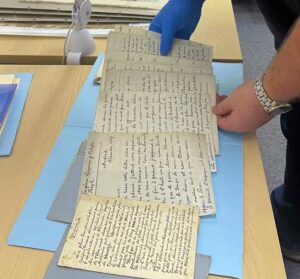France’s Emperor Napoleon III led a life that could rival any modern-day drama. This was a life filled with ambition, empire-building, betrayal, war, and a spectacular fall from grace that ended in exile and death in Britain. If it happened today, his story would dominate social media and make headlines worldwide.
Like many leaders throughout history, Napoleon III’s pursuit of power left a trail of destruction in its wake, likely including cultural treasures and historical records. It’s ironic, then, that at Camden Place in Chislehurst, Kent (his final place of exile), Ovation Data is helping to preserve the personal treasures and records that bring his legacy to life.
A tale that’s World Heritage Day worthy
The intertwined story of Napoleon III and Camden Place closely reflects the theme of this year’s World Heritage Day – the urgent need to prepare for threats to our cultural heritage, whether from conflict, disaster, or neglect. It’s a call to action for everyone in the heritage sector, from major museums and monuments to family collections and commercial archives, to protect and preserve the past. It has never been more necessary.
Beyond the global threats of political unrest, competition for resources, rising tensions, and extreme weather events, historic artifacts face daily risks from accidental damage, handling, exposure to moisture and light, pests, and more. Many collections are also housed in aging, fragile buildings, often ill-equipped to withstand the test of time or disaster.
Our fragile history
The early months of 2025 have already demonstrated the fragility of our historical records. Wildfires in California, the earthquake in Myanmar, and conflicts unfolding around the world have all contributed to the destruction of property and countless family heirlooms. Personal histories that often provide the most vivid window into past lives have been erased in moments.
These remnants, stories, and traditions shape our personal, cultural, and national identities, and preserving them helps us learn from history’s triumphs and failures. It deepens our understanding of human behavior, promotes empathy, fosters tolerance, and strengthens our appreciation for our world’s diverse cultures.
Digitizing historical documents and archival materials and planning for their long-term preservation are essential for safeguarding our heritage. Creating accurate digital copies (“faithful digital representations”) of physical assets builds a vital safety net that helps protect these irreplaceable resources from damage or loss. Just as importantly, capturing this information digitally helps make collections searchable and accessible, allowing a broader audience to engage with the items.
A treasure trove of heritage
Napoleon’s last home, Camden Place, is now home to Chislehurst Golf Club and offers a compelling example of the case for digitization and preservation. This Grade II-listed building has faced threats of its own over the years, including incendiary bomb damage during the 1940s and later, severe dry rot that endangered both the structure and the valuable archival materials stored within.
The house had received little attention since the golf club took on the tenancy in 1894. However, concerned about ongoing deterioration, a group of dedicated volunteers began to document its history and safeguard its archives. What started as a simple project soon uncovered a treasure trove of material tied to Napoleon III’s final years. As word of the project spread, private collections began arriving, including thousands of items once belonging to the tutor of Napoleon’s son, the Imperial Prince, found in an attic in Croydon. These rare materials, nearly lost and many in French, offered invaluable insight into a significant historical period.
However, the club faced a challenge familiar to many heritage custodians – how to make these fragile materials accessible while protecting them for posterity. The building’s primary function was as a clubhouse, not a museum. They lacked the resources for extensive public tours, sufficient display facilities to cope with the – now vast – collection and growing interest from French historians and researchers ready to uncover its secrets.
Digitizing archival materials

At this turning point, the volunteers approached Ovation Data and a partnership to digitize the archival collection began. At Ovation, we are experts in helping organizations digitize, preserve, and unlock the value of their historical collections. Following best practices in archival and collections care and handling, our experienced team uses a combination of specialized equipment and proprietary processing software to digitize archival content to client specifications. The new digital assets are made searchable with text recognition and metadata and can be securely stored in our archive to keep them safe and accessible over time.
The age and fragility of some of the materials in Camden Place’s collection made for a few challenges but with patience, attention to detail and technical expertise, we were able to digitize over 3,000 images. Even deteriorated items, like a faded photograph of Empress Eugénie, could be digitally enhanced (at Camden Place’s request) to reveal previously invisible details. And large broadsheet newspapers have been captured in their entirety, saved from the damage caused by regular unfolding.
This digital archive has become a heritage preservation success and a valuable educational resource. It helps protect the physical collection from future harm while enabling global access, academic collaboration, and international engagement, particularly from French audiences eager to explore this shared chapter of history.
On World Heritage Day 2025, we must recognize that digitization is not merely a convenience; it is a critical responsibility. Every artifact lost is – potentially – a story erased. By taking steps to digitize and preserve our archival collections today, we help ensure that the authentic voices, contexts, and lessons of the past remain alive for future generations, empowering us to build a more informed, empathetic, and resilient world.
Learn more about our services for heritage institutions or contact us to discuss your data challenges.